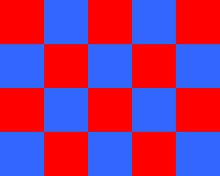|
|
| |
|
|
| |
|
|
|
|
| |
 |
| Four bags with three
marbles per bag gives twelve marbles (4 × 3 =
12). |
Multiplication
Multiplication (often denoted by the cross symbol x, by
the mid-line dot operator .,
by juxtaposition, or, on computers, by an asterisk *) is
one of the four elementary mathematical operations of
arithmetic, with the other ones being addition,
subtraction and division. The result of a multiplication
operation is called a product.
The multiplication of whole numbers may be thought of as
a repeated addition; that is, the multiplication of two
numbers is equivalent to adding as many copies of one of
them, the multiplicand, as the quantity of the other
one, the multiplier. Both numbers can be referred to as
factors.
The inverse operation of multiplication is division. For
example, since 4 multiplied by 3 equals 12, 12 divided
by 3 equals 4. Indeed, multiplication by 3, followed by
division by 3, yields the original number. The division
of a number other than 0 by itself equals 1. |
|
 |
| 4 × 5 = 20. The
large rectangle is composed of 20 squares, each
having dimensions of 1 by 1. |
Examples
2 x 3 = 6
2 x 4 = 8
2 x 5 =10
2 x 6 = 12
3 x 4 = 12
4 x 4 =16
4 x 5 = 20
4 x 6 = 24
2 x 3 x 5 = 6 x 5 = 30
2 x 2 x 2 x 2 x 2 = 32 |
|
Multiplication
table
In mathematics, a multiplication table (sometimes, less
formally, a times table) is a mathematical table used to
define a multiplication operation for an algebraic
system.
The decimal multiplication table was traditionally
taught as an essential part of elementary arithmetic
around the world, as it lays the foundation for
arithmetic operations with base-ten numbers. Many
educators believe it is necessary to memorize the table
up to 9 × 9.
History
The oldest known multiplication tables were used by the
Babylonians about 4000 years ago. However, they used a
base of 60. The oldest known tables using a base of 10
are the Chinese decimal multiplication table on bamboo
strips dating to about 305 BC, during China's Warring
States period.
The multiplication table is sometimes attributed to the
ancient Greek mathematician Pythagoras (570–495 BC). It
is also called the Table of Pythagoras in many languages
(for example French, Italian and Russian), sometimes in
English. The Greco-Roman mathematician Nichomachus
(60–120 AD), a follower of Neopythagoreanism, included a
multiplication table in his Introduction to Arithmetic,
whereas the oldest surviving Greek multiplication table
is on a wax tablet dated to the 1st century AD and
currently housed in the British Museum.
In 493 AD, Victorius of Aquitaine wrote a 98-column
multiplication table which gave (in Roman numerals) the
product of every number from 2 to 50 times and the rows
were "a list of numbers starting with one thousand,
descending by hundreds to one hundred, then descending
by tens to ten, then by ones to one, and then the
fractions down to 1/144."
In his 1820 book The Philosophy of Arithmetic,
mathematician John Leslie published a multiplication
table up to 99 × 99, which allows numbers to be
multiplied in pairs of digits at a time. Leslie also
recommended that young pupils memorize the
multiplication table up to 50 × 50. The illustration
below shows a table up to 12 × 12, which is a size
commonly used in schools. |
|
|
|
|
|
|
|
|
|
|
|
|
|
|
|
|
|
|
Search Fun Easy English |
|
|
|
|
|
|
|
|
|
|
|
|
|
|
|
About
Contact
Copyright
Resources
Site Map |